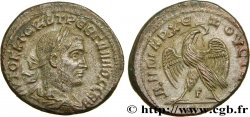Obverse
Obverse legend : IMP CAE C VIB TREB GALLVS AVG.
Obverse description : Buste lauré, drapé et cuirassé de Trébonien Galle à droite, vu de trois quarts en arrière (A*2).
Obverse translation : "Imperator Cæsar Caius Vibius Trebonianus Gallus Augustus", (L'empereur césar Caius Vibius Trébonien Galle auguste).
Reverse
Reverse legend : CONCORDIA AVGG S|C.
Reverse description : Concordia (la Concorde) assise à gauche tenant une patère et une double corne d’abondance.
Reverse translation : “Concordia Augustorum”, (La Concorde des augustes).
Historical background
TREBONIANUS GALLUS
(06/251-06/253)
Trebonian Galle, originally from Perugia, was governor of Moesia during the reign of Trajan Decius. During the battle of Abritus, he refrains from helping Decius in difficulty: the Emperor is killed by the Goths. Trebonian is proclaimed august and signs peace with Kniva. He hastens to return to Rome where he associates on the one hand Hostilian, the last surviving son of Trajan Decius, as august, and on the other hand his own son Volusien, as caesar. When Hostilian dies of the plague or is murdered, Volusian becomes august. Trebonian Galle pays tribute to the Goths as the Sassanids of Sapor I threaten Syria and the plague continues to ravage the Empire. He takes up the persecutions against Christians, but has no policy. The invasion having resumed on the Danubian limes with the arrival of new barbarian hordes, Emilian is proclaimed august by his troops and marches on Italy. Trébonien Galle calls on Valérien to rescue him and the decisive encounter takes place in Terni in 253. Trébonien Galle and Volusien are beaten and find death in the battle of which Émilien emerges victorious for a short time, before being assassinated by his troops who joined Valérien Ier.










 Report a mistake
Report a mistake Print the page
Print the page Share my selection
Share my selection Ask a question
Ask a question Consign / sell
Consign / sell
 Full data
Full data










